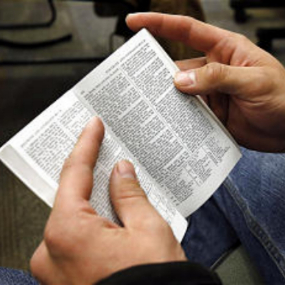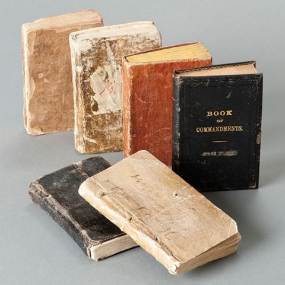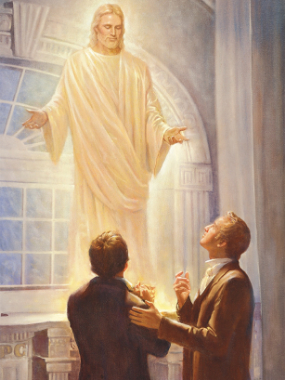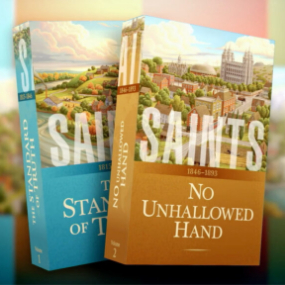| Temple Square is always beautiful in the springtime. Gardeners work to prepare the ground for General Conference. © 2012 Intellectual Reserve, Inc. All rights reserved. | 1 / 2 |
This story appears here courtesy of TheChurchNews.com. It is not for use by other media.
By Christine Rappleye, Church News
The introduction to the Doctrine and Covenants calls the book “unique” among the Church’s standard works because it is not a translation of an ancient text as are the Bible, Book of Mormon and Pearl of Great Price.
Initially called the Book of Commandments, the Doctrine and Covenants — this year’s focal point for “Come, Follow Me” curriculum for members of The Church of Jesus Christ of Latter-day Saints around the world — is a compilation of revelations given to prophets in answers to prayers as they worked to establish the Church and do the Lord’s work.
“One of the things that people find challenging in engaging with the Doctrine and Covenants a lot of the times is that it does not have a narrative,” said Lisa Olsen Tait, who is a Church historian with an expertise in Latter-day Saint women’s history. “The text itself doesn’t tell a story that you can hold on to in the way that the Book of Mormon does, for example, with people speaking, characters to follow and a storyline.”
Tait joined fellow historians Matt McBride, director of the Church History Department’s Publications Division, and Matthew Godfrey, managing editor of the Joseph Smith Papers, in sharing several ways and resources that can help those studying the Doctrine and Covenants.
1. See Real People in Real Situations
McBride suggested looking from “the outside in.”
“Do what you can to understand the setting and circumstances in which each section was given or produced,” he said. “The Doctrine and Covenants has been called a book of answers, but it is on us to try to understand what the questions were,” McBride said.
The headings can help provide some of the context quickly, he added.

DC
Students participate in a Doctrine and Covenants class taught in Salt Lake City, Tuesday, February 18, 2014. Photo by Ravell Call, courtesy of Church News.Copyright 2021 Deseret News Publishing Company.In addition, resources have been compiled in “Doctrine and Covenants Historical Resources” and organized along the same schedule as “Come, Follow Me — For Individuals and Families,” drawing from the “Saints” series, “Revelations in Context,” the Joseph Smith Papers project, and additional information on the people, places and chronology. These are linked to in the lessons online and in the Gospel Library app. (See list below.)
“When we take the time to understand the context of the sections, we come away with different insights than if we just take the text at face value. In particular, I feel like this has given me a greater appreciation for the way the Lord works with the prophet, the Church and with me,” McBride said.
Tait sait that while studying the background and understanding the situations that prompted the revelations, it’s important to study the revelations themselves, too.
“I always tell people, don’t let that be a substitute for engaging with the text itself,” she said. “The revelations themselves are very rich and very powerful. And there’s no other way to get what’s in there than to read them and to deeply engage with what’s in the revelations.”
2. Look for the Savior
The Doctrine and Covenants also testifies of the Savior and the Atonement.
Said Godfrey: “There’s these passages in the Doctrine and Covenants where we will learn a lot about the mercy of the Lord, about the Savior’s Atonement and what it took for Him to do the things that He did and what it means for us in our lives, not only in terms of being forgiven of sin, but to help us get through the trials we face.”
For example, Section 76 provides a description of the Savior, Section 19 focuses on the Atonement, Section 122 offers comfort, and Section 45 explains the Savior as the Advocate.
3. Notice Instructions for Building Zion
One of the threads through the Doctrine and Covenants is the tome of scriptures as a type of handbook for gathering Zion.
“You see in the Doctrine and Covenants many revelations from Joseph Smith that talk about how do we build the city of Zion? And what is it supposed to look like? And how can we be unified?” Godfrey said.
That changes from the ways of physically building a city to building Zion communities.
4. Look for Connections Between Scriptures

DC
Six different volumes of the book that became the Doctrine and Covenants.2021 by Intellectual Reserve, Inc. All rights reserved.One of the ways Tait studies the scriptures is to look for connections between the books of scripture.
“It’s woven together in a really intricate way — all of these references from the Bible,” Tait said, noting how the texts echo each other.
She also sees this in the Book of Mormon, of how many things that are in the Doctrine and Covenants are also taught or illustrated in the Bible.
“It helps us to be aware of this idea that the Bible and the Doctrine and Covenants are really connected. And that the Lord brings together all the dispensations really in the Doctrine and Covenants in the revelation,” Tait said.
5. Watch for Fulfilled Revelations
Godfrey suggests the reader remember that these revelations were directed at real people.
“There was a very real component of ‘I’m an ordinary Church member, how do I fulfill what the Lord is telling us to do here?’” he said.
When Joseph Smith received the revelation in Section 101, it was when the Saints were being driven out of Missouri and includes a parable and instructions on how the Saints are to redeem Zion, Godfrey said. The instructions include verses 70-73 to “purchase all the lands with money, which can be purchased for money in the region round about the land which I have appointed to be the land of Zion.”
When the branch leaders in Lewis, New York, heard about this revelation, they decided that to fulfill this revelation. They were going to donate as much money as they could and assign a wise man to take this money to Missouri to help purchase the land.
One of those who donated money was 21-year-old Caroline Tippet. She donated $250 of the $850 the branch raised to send to Church leaders and went with her brother Harrison Tippet and cousin John to deliver the money.
They stopped by Kirtland, Ohio, and due to the financial situation there, the Tippets were asked to loan some of the money to Joseph Smith. And Caroline Tippet was called into the meeting, too, as she donated a large part of it.
Joseph wrote in his journal that he and Oliver Cowdery knelt down and thanked the Lord for the financial relief.
“These revelations had some very specific applicability to the people living at the time, and they had to figure out how are we going to obey these things. How are we going to fulfill these commandments that the Lord has given?” Godfrey said.
6. Notice the Pattern for Receiving Revelation
Doctrine and Covenants shows Joseph Smith asking a variety of questions, both large and small, McBride said.
“The story of the early Church was full of trial and error and real-world experience, as well as prayer and miracles. But that is what makes it enjoyable for me to study,” he said. “I can relate to their struggles as they try to approach God as imperfect people in an imperfect world.”
In Church history, there are records of visions that Joseph Smith did have — such as the First Vision, other visions and the visitations at the Kirtland Temple and what became Doctrine and Covenants 76. But many of the revelations came in a way similar to how other people can receive answers to prayers.

DC
A painting depicting the Savior's appearance to Joseph Smith and Oliver Cowdery in the Kirtland Temple.2021 by Intellectual Reserve, Inc. All rights reserved.“It’s interesting, I think, that for the vast majority of the revelations that are in the Doctrine and Covenants, they came to Joseph Smith the same way the Lord reveals things to us,” Godfrey said. “It was through inspiration that he received His heart into his mind.”
Godfrey pointed to a description by William E. McLellin that Joseph “spiritually sees, hears and feels and then speaks as he is moved upon by the Holy Ghost.”
“That’s something that has helped me understand a little bit better that the Lord works with our prophets and apostles the same way that He works with us,” Godfrey said.
7. Recognize ‘What We Don’t Know’
The historians pointed to several resources to help understand some of the more challenging aspects of the Church’s history.
“When we come across these difficult questions and issues in the past, it always helps to contextualize, try to understand what’s going on, how the people involved understood what was going on, to the degree that we can,” Tait said. “It’s important to know what we know and what we don’t know. And many times, we don’t know very much.”
Also, having patience and humility is important, McBride said.
“I try to be patient with imperfect members and leaders from the past, patient with myself while I take time to understand how the new things I learn fit in with what I previously understood, and patient with the ambiguity and uncertainty that characterizes this life,” he said. “We really have to be humble about our knowledge of the past because it comes with so many limitations. And I also try to be humble about what I think I know.”
Resources to Studying Church History
In addition to the “Come, Follow Me” manuals, McBride, Godfrey and Tait suggested considering several additional resources.
- “Saints: The Story of the Church of Jesus Christ in the Latter Days, Vol. 1 — The Standard of Truth, 1815–1846” and “Saints: The Story of the Church of Jesus Christ in the Latter-day Days, Vol. 2 — No Unhallowed Hand, 1846-1893”: The history of the Church shared as a narrative. (Found in the Gospel Library app under Restoration and Church History; also available in print).

DC
A screenshot from a video shows both volumes 1 and 2 of the series "Saints."2021 by Intellectual Reserve, Inc. All rights reserved.
- “Revelations in Context”: Contains information about the people, places and context of the revelations in the Doctrine and Covenants (Found in Gospel Library, then Restoration and Church History, and under Doctrine and Covenants Study; also available in print).
- Church History Topics: Similar in format to the Gospel Topics, with an alphabetical list of terms and definitions. (Found in the Gospel Library under Restoration and Church History).
- “Doctrine and Covenants Historical Resources”: Organized along the dates of the “Come, Follow Me” lesson, this draws from the Joseph Smith Papers, “Saints,” “Revelations in Context” and others Church history resources for specific sections. (Found in Gospel Library, Restoration and Church History, Doctrine and Covenants Study).
- Church magazines: In addition to articles and resources throughout the year, here are some monthly features. (Found in Gospel Library, then Magazines).
- The Friend: Church History Cards with a person and a brief biographical sketch.
- For the Strength of Youth: People from Church history with an illustration and facts about him or her.
- Liahona: Early Women of the Restoration highlights a woman from Church history.

DC
Students participate in a Doctrine and Covenants class taught in Salt Lake City, Tuesday, February 18, 2014. Photo by Ravell Call, courtesy of Church News.2021 by Intellectual Reserve, Inc. All rights reserved.
Other resources — including videos, the Church’s history in many different countries and women’s history — are also available on the churchofjesuschrist.org website and in the Gospel Library app under Restoration and Church History.
Copyright 2020 Deseret News Publishing Company

